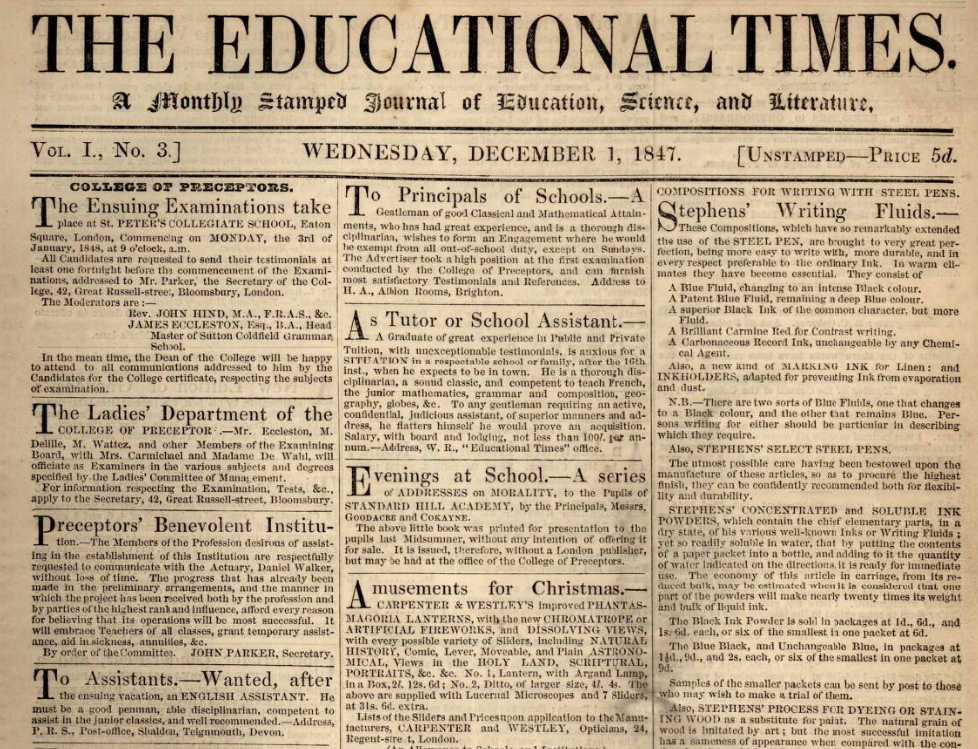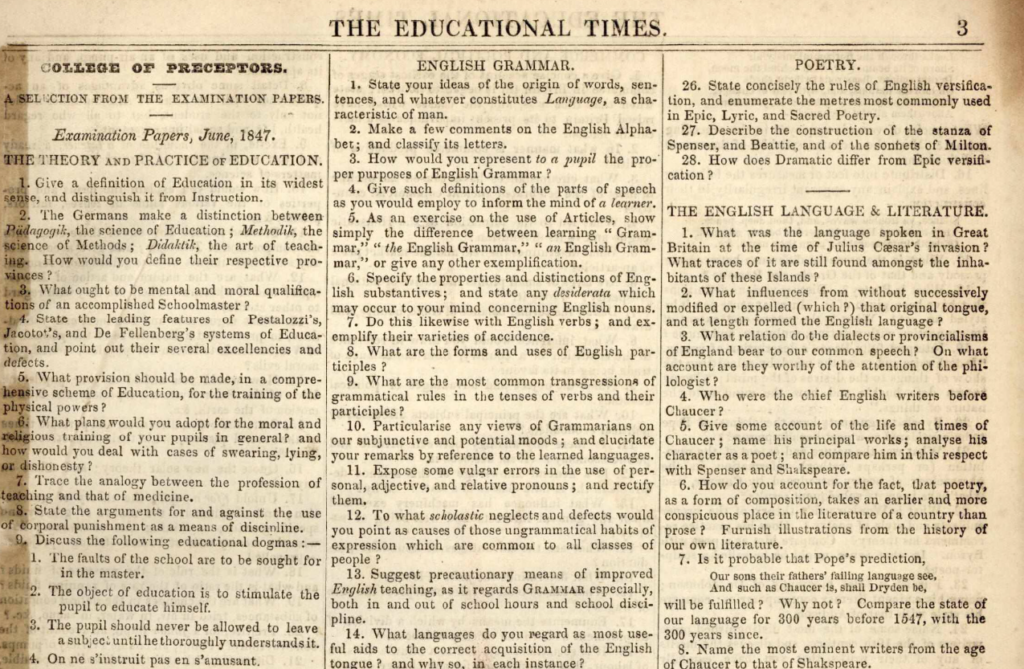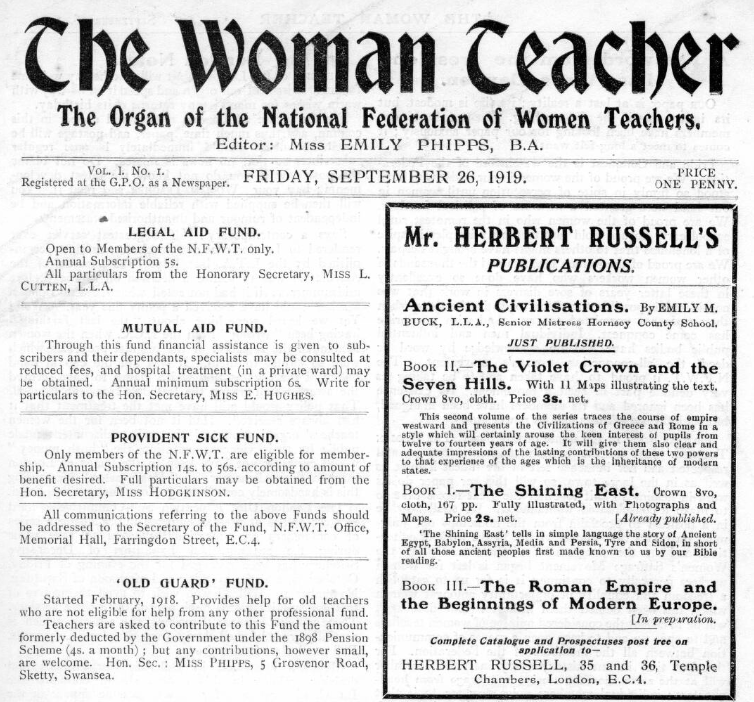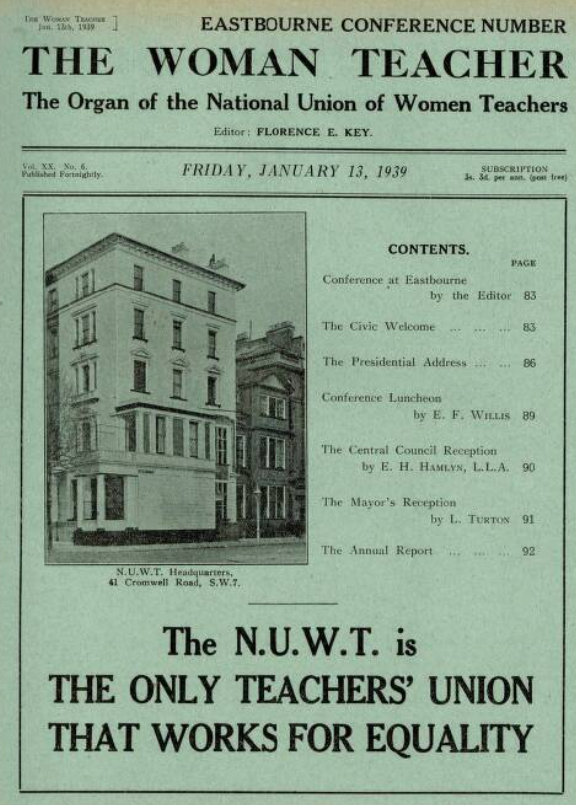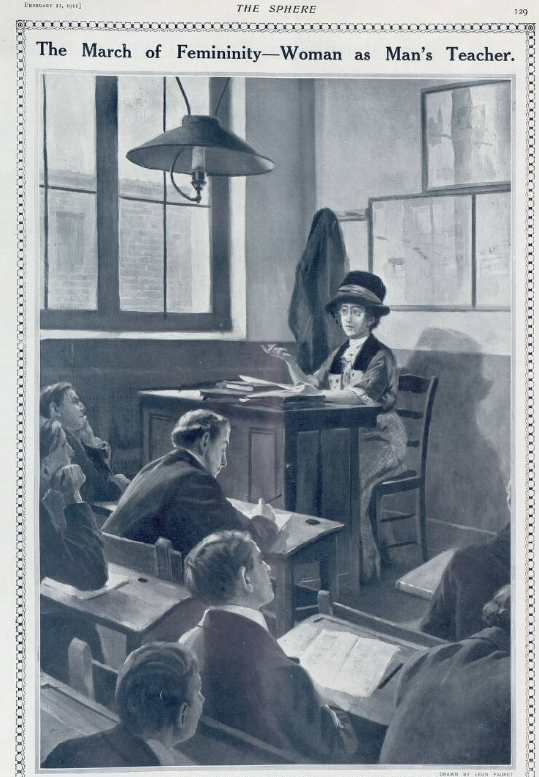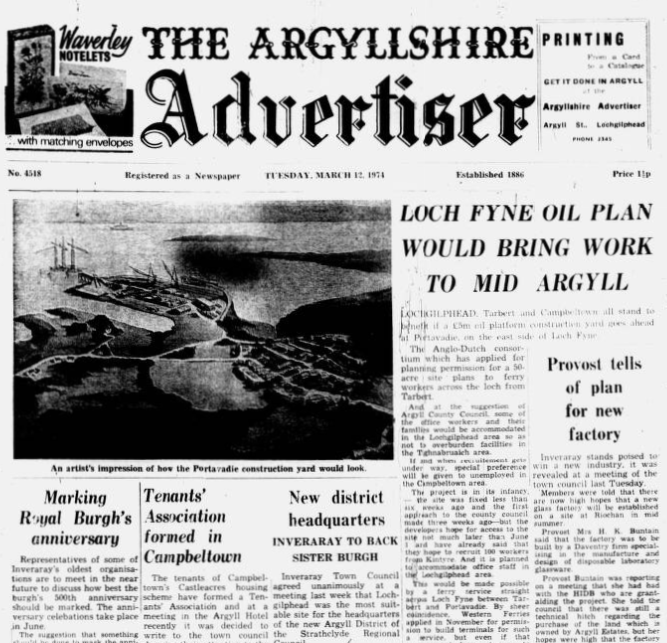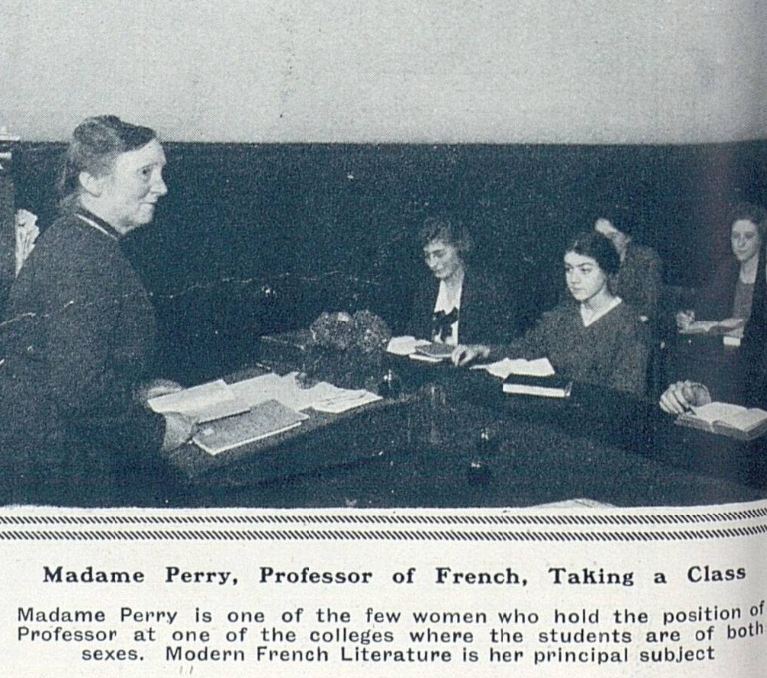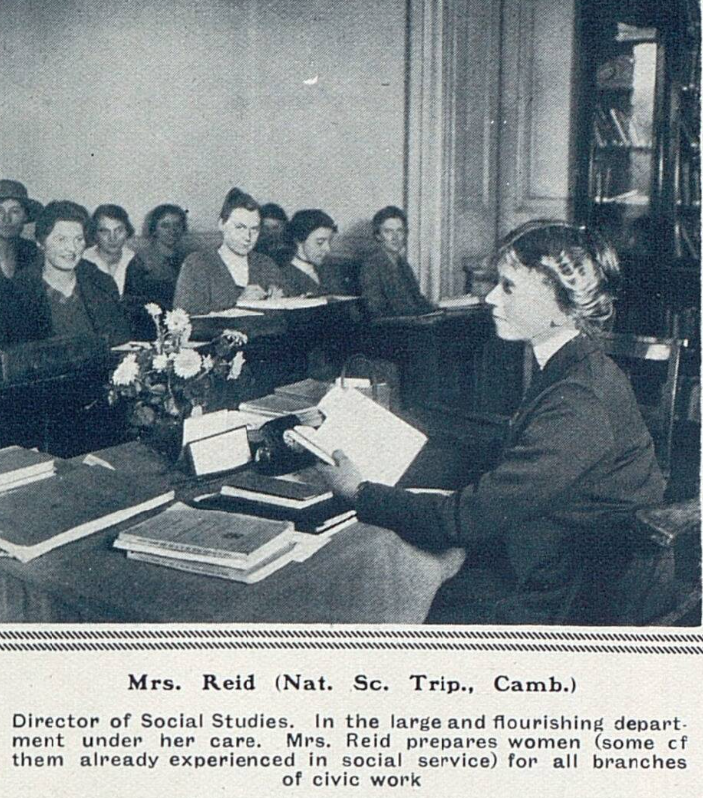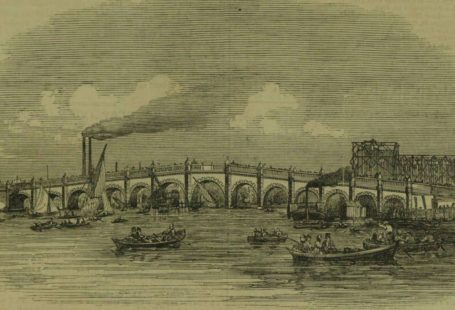This week at The Archive we are going back to school with the addition of a duo of new scholastic titles, the Educational Times and the Woman Teacher. As if that wasn’t exciting enough, we’ve added another new title, the Argyllshire Advertiser, whilst we’ve also now surpassed the 83 million pages mark, as we have added a total of 258,481 brand new pages over the last week alone.
Meanwhile, from Belfast to Beverley, from Derry to Durham, from Peterborough to Portadown, we’ve updated a whopping 53 of our existing titles from across the United Kingdom. So read on to discover more about our trio of new titles this week, and also to learn about the ending of the marriage bar in 1944, which allowed married women teachers to continue in their professions.
Register now and explore the Archive
We begin our foray through our new scholastic titles this week with the Educational Times, which was first published on 2 October 1847. Priced at 6d., it was labelled as ‘a Monthly Stamped Journal of Education, Science, and Literature.’ However, the Educational Times was much more than this. Indeed, it was the journal of the College of Preceptors, which was the first ever professional body for teachers in the United Kingdom, which had been founded in 1846 in Brighton by Henry Stein Turrell.
The College of Preceptors represented an effort to help create and maintain standards in the teaching profession, a profession that at the time was often looked down upon. The organisation aimed to do this by providing formal training for teachers, and also by creating new standards for pupils. The College of Preceptors pioneered exams, being the first body in the United Kingdom to examine and certify pupils, with such examinations being first tested in Nottingham. Indeed, you can find some early exam questions in the Educational Times here.
Women were admitted to the College of Preceptors in 1849, although a Ladies’ Department existed within the Educational Times from its inaugural issue. The first ever Ladies’ Department section noted how, on 2 October 1847, ‘this collateral institution, established to promote the greater efficiency of schoolmistresses and governesses, and to protect their interests, is now in operation.’
So what sort of content did the Educational Times feature? The monthly journal published the latest news from across schools and universities in Britain, as well as details about forthcoming and past examinations. It printed articles on a range of subjects, like natural history and art education, whilst also featuring extensive reviews of books and plays, alongside worked examples of mathematical problems.
The Educational Times was going strong by the turn of the century, when it was known as the Educational Times and Journal of the College of Preceptors. The title featured extensive adverts for different educational tools, such as maps and books, as well as printing news of appointments and vacancies within the teaching profession.
By 1920 the journal was subtitled as A Review of Ideas and Methods, focussing on showcasing different teaching methods. It looked a diverse subjects like ‘Leadership and Class Discipline,’ cramming, and even the ‘Evils of the Cinema.’ By this point in time the Educational Times had expanded to feature personal notices from those within the teaching profession, alongside obituaries of teachers and lecturers.
In 1924 the journal became the Education Outlook and Educational Times. For us today, the paper sheds an important light on the formalisation of the education system and the evolution of teaching methods across the Victorian era and beyond.
Our next new title of the week is the Woman Teacher, which was first published on 26 September 1919 as the ‘Organ of the National Federation of Women Teachers.’ Unlike the Educational Times, the Woman Teacher was a weekly affair, and cost only one penny. It was founded with the aim of securing equality within the teaching profession for women, with a focus on equal pay and conditions, as well as the marriage bar, which prevented married women from continuing with their careers.
Indeed, Federation president Agnes Dawson issued this rallying cry in the inaugural edition of the Women Teacher:
We take pride in the name of our paper…Just as the woman teacher is known and respected and her influence felt in the tiniest hamlet as well as in the largest town, so will this her paper do its work in helping to knit together the great forces that go to make a consolidated womanhood. We shall now be in a position to proclaim from the housetops our judgement on things that matter vitally to the work of education and to the progress of civilisation.
The National Federation of Women Teachers traces its origins back to 1896, when the National Union of Teachers (NUT) founded a Ladies’ Committee. Fast forward to April 1904, when the Equal Pay League was formed, which subsequently became known as the National Federation of Women Teachers in 1906. However, frustrated with the male-led NUT, the Federation became its own union in 1920, becoming known as the National Union of Women Teachers (NUWT). The 28 May 1920 edition of the Woman Teacher marked this change, displaying the new Union’s objectives on its front page, as it would do for many editions to come.
The Woman Teacher, therefore, was a battling publication, keeping its members informed on matters relating to equal pay. Meanwhile it also featured articles on wider educational matters, whilst printing reports on conferences and book reviews.
Katie McBride Moench, writing on the Woman Teacher, describes how its articles called ‘members to radical action for equality.’ Moench relates how this call became particularly necessary in the 1930s, when dual membership of the NUT and NUWT was prohibited, and the seceding of the National Association of Schoolmasters (NAS) from the NUT highlighted entrenched misogynistic views both within in the teaching profession and society as a whole. Essentially, NAS put forward that as men were intellectually superior to women, women should not be allowed to teach boys and young men.
This radical, campaigning, newspaper, which featured articles by pioneering women educators, won several victories over the years, including the ending of the marriage bar, and eventually, equal pay. The last edition of the Woman Teacher appeared on 1 March 1961, after this final and most important victory, after many decades, had finally been achieved. The NUWT, meanwhile, no longer exists today.
Our final new title of the week is the Argyllshire Advertiser. This title was founded in 1886 in the Argyll town of Lochgilphead, which lies at the end of Loch Gilp. A weekly newspaper, the paper serves the mid-Argyll and North Kintyre areas, and is still published to this day.
That may be it from our two new educational titles this week, plus the Argyllshire Advertiser, but with 53 of our existing titles updated this week, there’s still plenty for you to explore. It’s a particularly good week for our Northern Irish titles, with 8 titles from Northern Ireland seeing updates, additions of note being to the Banbridge Chronicle and the Belfast News-Letter. We’ve not neglected our Scottish titles this week either, as we see updates to the Fraserburgh Herald and Northern Counties’ Advertiser.
Ending the Marriage Bar
In early 1944 it was still possible for women to be barred from the teaching profession if they married, something that was known as the marriage bar. Following the passing of the Education Act in January 1944, which looked at removing inequalities within the education sector, still women could be dismissed from their teaching posts solely based on their marital status.
The marriage bar was something that campaigning newspaper the Woman Teacher had fought for the dissolution of for some time. On 7 April 1944 the newspaper reported how things were set to change, relating how ‘on Friday, March 10th, Mr. Hamilton-Kerr (Oldham) moved an amendment to the Education Bill to secure that a teacher shall not be ‘subject to dismissal solely by reason of marriage.’
This movement was seconded by Minister of Education Rab Butler, who ‘stated that the Government had come to the conclusion that they should take action on the lines suggested and he undertook to include an amendment ‘which will provide that a teacher shall not be dismissed solely on grounds of marriage.’’ This caused NUWT General Secretary A.M. Pierotti to compose the following lines:
The N.U.W.T. welcomes any movement designed to secure the removal of the ban on married women teachers; but our claim is not based on expediency for the moment, the present shortage of teachers, or the desire to offer married women a reward for having returned to schools during the war. It is based on the right of the individual, whether man or woman, married or single, to serve the community according to his or her capacity and choice, without the arbitrary introduction of a prohibition based on an extraneous condition unrelated to capacity to perform the work.
Pierotti doubled down, going on to state:
Thus, it is not sufficient to provide that women teachers ‘shall be dismissed solely on the grounds of marriage,’ but it should be made clear that there must be no discrimination against women teachers on the grounds that they are married, and that they have the same rights of appointment and promotion as obtain for men and single women.
Two years after the removal of the marriage bar, women teachers were still facing discrimination. This was evidenced by the Woman Teacher in June 1946, when the M.P. for Cardiff Central, Mr. G. Thomas, asked the Minister of Education Ellen Wilkinson whether or not she was ‘aware of the decision of the Glamorgan County Council to dismiss a married woman teacher on grounds of pregnancy and whether she proposed to take action to prevent this dismissal.’
The Minister responded how it was her opinion that the ‘dismissal of a married woman teacher solely on the grounds of pregnancy ‘is precluded by Section 24 (3) of the Education Act, 1944.’’ The Woman Teacher welcomed this statement, for ‘notwithstanding the removal of the marriage bar, discussions on the dismissal of married women teachers are already taking place in some local education committees and the anticipated complaints against married women keeping ex-servicemen out of jobs are beginning to appear in the national and local press.’
On 1 March 1961, in the final edition of the Woman Teacher, Welsh contributor Kate Fisher looked ‘back with pride’ on the ‘outstanding victories’ gained during the publication of the NUWT title. The victories were: the gaining of the equal franchise in October 1928, the removal of the marriage bar in March 1944, and equal pay for men and women in March 1955, ‘albeit on a seven year instalment plan.’
Fisher ended her piece with this powerful statement, reminding us today that there is still much to be done to secure the equality for which this pioneering group of women so passionately and effectively fought:
To the youth of today, these victories have become adopted facts – part of their heritage – but I have no doubt but that they will be their accepted instruments to forge the new social order – a social order built on complete legal, political and economic emancipation for women everywhere.
Discover more about women teachers, the history of education, and much more besides, in the pages of our newspaper Archive today.
New Titles
| Title | Years Added |
| Argyllshire Advertiser | 1974-1975 |
| Educational Times | 1847-1851, 1853-1881, 1883-1894, 1897-1923 |
| Woman Teacher | 1919-1961 |
Updated Titles
This week we have updated 53 of our existing titles.
You can learn more about each of the titles we add to every week by clicking on their names. On each paper’s title page, you can read a free sample issue, learn more about our current holdings, and our plans for digitisation.
You can keep up to date with all the latest additions by visiting the recently added page. You can even look ahead to see what we’re going to add tomorrow.


